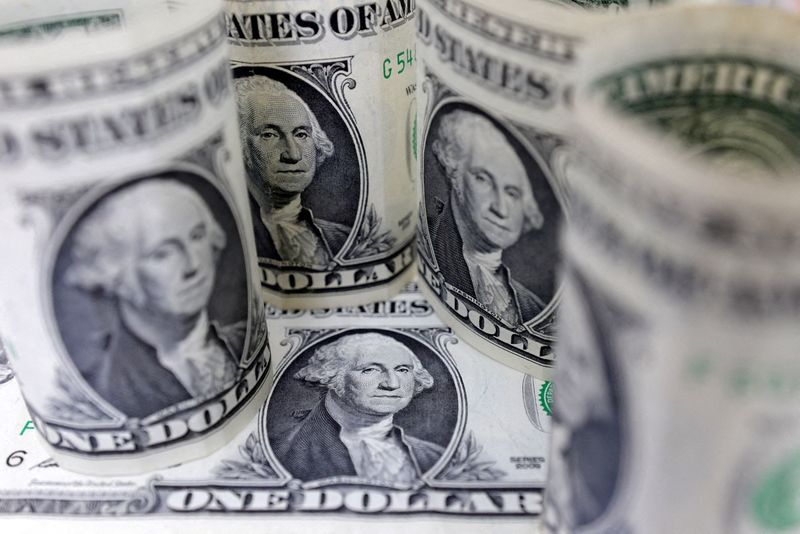By Gertrude Chavez-Dreyfuss
NEW YORK (Reuters) -The dollar rose on Thursday as a mixed batch of U.S. data did little to shake views that the economy is still on solid ground, suggesting the Federal Reserve will likely delay the timing of its first interest rate cut since 2020 to later this year.
Comments from New York Fed President John Williams saying there is no urgent need to cut interest rates right now given the strength of the economy, also helped lift the dollar. The New York Fed president is always a voter on the central bank’s policy-setting committee.
A warning by finance chiefs of the United States, Japan and Korea over sharp decline in the yen and won weighed, however, on the dollar overnight and gave the yen some rare respite. But the impact has since dissipated.
The yen had risen modestly on Wednesday after Japan’s top currency diplomat Masato Kanda said finance leaders of the G7 reaffirmed their stance that excessive currency volatility was undesirable.
But strong U.S. economic data and persistent inflation have prompted investors to drastically rethink the chances of the Fed cutting rates any time soon. On Thursday, that strength was on display once again.
Manufacturing activity in the U.S. Mid-Atlantic region expanded by the most in two years in April on the strength of new orders and shipments of finished goods.
The Philadelphia Fed’s monthly business conditions index rose to 15.5 from 3.2 in March, exceeding the median estimate among economists for a reading of 2.3 and overshooting even the most optimistic forecast among 34 economists surveyed.
“It’s really hard to fight dollar strength right now. U.S. data continues to suggest that the Fed is not going to be cutting any time soon,” said Vassili Serebriakov, FX strategist, at UBS in New York.
“We’re starting to see more policy divergence priced between the U.S. and the rest of G10. When you look at the 10-year real rate differentials between the U.S. and Europe, those have widened in favor of the dollar.”
Other economic reports on Thursday were neutral to weak. U.S. initial jobless claims were unchanged at a seasonally adjusted 212,000 for the week ended April 13, data showed, still higher than the forecast of 215,000.
In the housing sector, U.S. existing home sales fell in March as higher interest rates and house prices sidelined buyers. Home sales dropped 4.3% last month to a seasonally adjusted annual rate of 4.19 million units.
In afternoon trading, the , which measures the U.S. currency against six of its peers, rose 0.2% at 106.15, still within reach of this week’s 5-1/2-month high of 106.51 hit on Tuesday. The index has been up 4.5% so far this year.
The Japanese currency slipped against the dollar, pushing the greenback up 0.1% to 154.580 yen, not far from the yen’s 34-year low of 154.79 hit on Tuesday.
Market participants have raised the bar on possible intervention by Japanese authorities to prop up the yen, now pointing to the 155 level, even though they believe Japan could step in any time.
Bank of Japan Governor Kazuo Ueda said on Thursday the central bank may raise interest rates again if the yen’s declines significantly push up domestic inflation.
In other currencies, the euro slid 0.3% against the dollar to $1.0643. slipped 0.1% to $1.2440.
U.S. rate futures on Thursday have priced in about 38 basis points of easing in 2024, or 1-1/2 cuts of 25 bps each. That has been a steep reduction from the six quarter-point easing at the start of the year. Traders see September as the most likely starting point for the cut, versus June just a couple of weeks ago, based on the CME FedWatch Tool.
“We’ll get the U.S. GDP (gross domestic product) number next week, but people are looking beyond that now. The next big number is the jobs data on May 3rd, which is likely to show a solid number, say north of 250,000,” said Marc Chandler, chief market strategist, at Bannockburn Forex in New York.

“The market is also making that adjustment in terms of Fed policy. The fed funds futures are showing about 1-1/2 cuts, which tells me there is room to get that to just one cut.”
In cryptocurrencies, bitcoin rose 4.4% to $63,508 ahead of the widely anticipated halving event in the next few days. halving refers to a technical adjustment built into the digital currency’s code which reduces the rate at which new coins are created.










